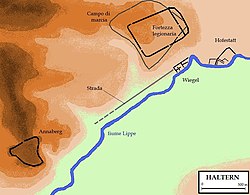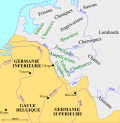
Arminius was a Roman officer and later chieftain of the Germanic Cherusci tribe who is best known for commanding an alliance of Germanic tribes at the Battle of the Teutoburg Forest in 9 AD, in which three Roman legions under the command of general Publius Quinctilius Varus were destroyed. His victory at Teutoburg Forest would precipitate the Roman Empire's permanent strategic withdrawal from Germania Magna. Modern historians have regarded Arminius' victory as one of Rome's greatest defeats. As it prevented the Romanization of Germanic peoples east of the Rhine, it has also been considered one of the most decisive battles in history, and a turning point in world history.
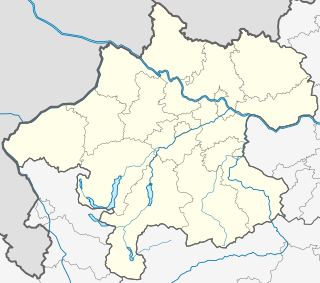
Wels is a city in Upper Austria, on the Traun River near Linz. It is the county seat of Wels-Land, and with a population of approximately 60,000, the eighth largest city in Austria.

Hans Dragendorff was a Baltic German scholar who introduced the first classification system for the type of Ancient Roman pottery known as Samian ware or Terra sigillata, in 1896, using type numbers. His scheme was based on the varying forms the vessels took and although it has since been augmented and refined by others, it is still common to refer to 'Dragendorff type 37' bowls for example.

Terra sigillata is a term with at least three distinct meanings: as a description of medieval medicinal earth; in archaeology, as a general term for some of the fine red Ancient Roman pottery with glossy surface slips made in specific areas of the Roman Empire; and more recently, as a description of a contemporary studio pottery technique supposedly inspired by ancient pottery. Usually roughly translated as 'sealed earth', the meaning of 'terra sigillata' is 'clay bearing little images', not 'clay with a sealed (impervious) surface'. The archaeological term is applied, however, to plain-surfaced pots as well as those decorated with figures in relief.

Rheinzabern is a small town in the south-east of Rhineland-Palatinate in Germany near the Rhine river. Currently, Rheinzabern, that belongs to the District of Germersheim has approx. 5000 inhabitants living on an area of 12,75 square kilometres.
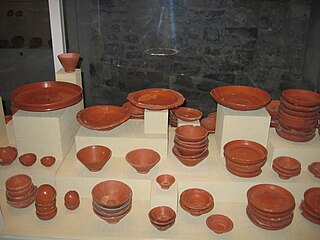
La Graufesenque is an archaeological site 2 km from Millau, Aveyron, France, at the confluence of the rivers Tarn and Dourbie. As Condatomagus, it was famous in the Gallo-Roman period for the production of high quality dark red terra sigillata Roman pottery, which was made in vast quantities and exported over much of the western part of the Roman Empire.
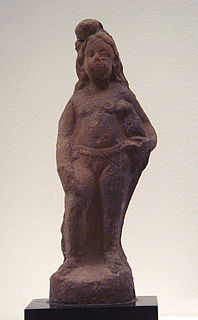
Arikamedu is an archaeological site in Southern India, in Kakkayanthope, Ariyankuppam Commune, Puducherry. It is 4 kilometres (2.5 mi) from the capital, Pondicherry of the Indian territory of Puducherry.

Flevum was a castrum and port of the Romans in Frisia, built when emperor Augustus wanted to conquer the German populated territories between the Rhine river and the Elbe river.

The Roman Forum of Lahnau-Waldgirmes is a fortified Roman trading place, located at the edge of the modern village Waldgirmes, part of Lahnau on the Lahn, Hesse, Germany. The site has the oldest known stone buildings in Magna Germania.

Georg Loeschcke was a German archaeologist born in Penig, Saxony.
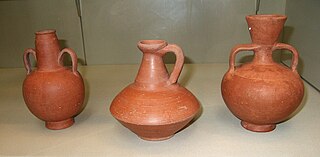
African red slip ware, also African Red Slip or ARS, is a category of terra sigillata, or "fine" Ancient Roman pottery produced from the mid-1st century AD into the 7th century in the province of Africa Proconsularis, specifically that part roughly coinciding with the modern country of Tunisia and the Diocletianic provinces of Byzacena and Zeugitana. It is distinguished by a thick-orange red slip over a slightly granular fabric. Interior surfaces are completely covered, while the exterior can be only partially slipped, particularly on later examples.

Pottery was produced in enormous quantities in ancient Rome, mostly for utilitarian purposes. It is found all over the former Roman Empire and beyond. Monte Testaccio is a huge waste mound in Rome made almost entirely of broken amphorae used for transporting and storing liquids and other products – in this case probably mostly Spanish olive oil, which was landed nearby, and was the main fuel for lighting, as well as its use in the kitchen and washing in the baths.

A ceramics museum is a museum wholly or largely devoted to ceramics, usually ceramic art. Its collections may also include glass and enamel, but typically concentrate on pottery, including porcelain. Most national collections are in a more general museum covering all of the arts, or just the decorative arts. However, there are a number of specialized ceramics museums, with some focusing on the ceramics of just one country, region or manufacturer. Others have international collections, which may be centered on ceramics from Europe or East Asia or have a more global emphasis.
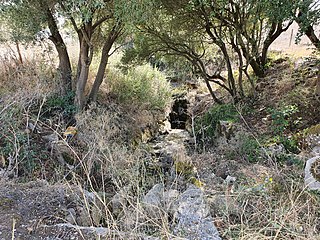
The archaeological site of Colaride, is a Roman necropolis in a natural cave, located in the Portuguese civil parish of Agualva e Mira-Sintra, municipality of Sintra.

The Roman camp at Marktbreit is a castrum with a nearby Canabae from the period of Emperor Augustus. It is located in the municipal territory of the Lower Franconian town of Marktbreit on the left bank of the River Main, in the district of Kitzingen inside the German state of Bavaria.

The Wetterau Limes is the name given in the field of historical research to that part of the Upper Germanic-Rhaetian Limes which enclosed the region that became known later as the Wetterau in the German state of Hesse.
The Lautertal Limes is a Roman limes section of the early 2nd century which is located between the River Neckar and the Swabian Jura. It extends for a distance of 23 kilometres (14 mi), running, straight as a die, from the present-day municipality of Köngen on the Neckar in the northwest to Donnstetten in the Swabian Jura to the southeast.
Brenda Dickinson is a British archaeologist. She is a leading scholar in the study of Roman pottery, and a specialist in Roman potter's stamps.

The Roman villa of Tourega is in the parish of Nossa Senhora da Tourega in the Évora District of the Alentejo region of Portugal. During Roman occupation of Portugal it was part of the province of Lusitania, situated a few kilometers to the southwest of Civitas Ebora Liberalitas Julia, the modern-day Evora. It was next to the Roman road to Salacia and only five kilometers from the Roman road to Pax Julia, the modern-day Beja. Excavations indicate that it was in use between the mid-first century CE and the end of the fourth century and that, at least in the third century, it belonged to a family of senatorial rank. The Villa, which was primarily used for farming, was classified as a Site of Public Interest in 2012.
Astrid van Oyen is currently an Assistant Professor in Classics at Cornell University. She is a leading archaeologist studying the social, economic and cultural aspects of empire, rural economies, craft production, and storage in Italy and the western provinces.

